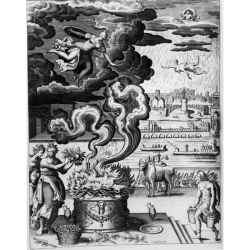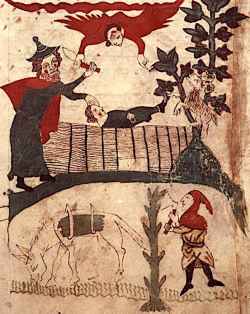Topic: 2. Sacrifice and religion: Comparisons, Antiquarians, Anthropology (16th-18th Century)
Religious sacrifices across various cultures and contexts sparked widespread interest in Early Modern Europe. As Christianity expanded into regions inhabited by "infidels" and "pagans", Europeans encountered a diverse array of sacrificial customs, ranging from the Sati rituals in India to the Aztec sacrifices in the Americas. This cross-cultural exposure captivated a wide audience, including theologians, philosophers, political thinkers, antiquarians, orientalists, missionaries, poets, artists, and even the general public. These encounters broadened the European understanding of sacrifice and led to a critical reassessment of classical and biblical sacrificial rites. This section includes:
- Sources: A selection of early modern printed materials, which include descriptions of the Americas, Asia, and Africa, alongside antiquarian and philological studies on religious sacrifice in classical antiquity and beyond. It also presents early modern works of ethnological observations and the first attempts to compare different sacrificial practices in various traditions and contexts, laying the groundwork for disciplines like the history of religions and anthropology.
- Iconographic Representations: A rich collection of images from the 16th to 18th centuries, illustrating a range of sacrificial rituals and practices as seen in different cultural and geographical contexts.
- Related Bibliography: An extensive bibliography spanning scholarly works from the 19th to 21st centuries, providing contemporary analyses and interpretations of these early studies and observations.
Cattolici, antisemitismo e sangue. Il mito dell'omicidio rituale. In appendice il voto del cardinale Lorenzo Ganganelli, O.F.M. (poi Papa Clemente XIV) approvato il 24 dicembre 1759
Milano: Sugarco, 2004.
The Athenians sacrifice to the newborn Minerva (1629)
from: Philostratus of Lemnos. Les images ou tableaux de platte peinture des deux Philostrates, sophistes grecs, et les Statues de Callistrate, tr. Blaise de Vigenère. Paris. 1629, p. 510
Warburg Institute
The Iconography of the Sacrifice of Abraham
in: Vigiliae Christianae , v. 15 (1961), issue 4: pp.214–55.
Passing : Jesus' Circumcision and Strategic Self-sacrifice
in: Ancient Mediterranean Sacrifice, pp. 251-264
Oxford: Oxford University Press, 2011.
Missionary Methodology and the Making of Aztec Human Sacrifice: Decolonizing a Concept
in: Method and Theory in the Study of Religion, v. (2023), issue : pp.1-36.
The Sacrifice of Isaac (1348)
from: Mahzor
Darmstadt | Universitäts- und Landesbibliothek Darmstadt, Cod. Or 13, fol. 202
Chap. 2: Rites
in: The religion and rituals of the nomads of pre-Islamic Arabia : a reconstruction based on the Safaitic inscriptions, pp. 17-55
Leiden: Brill (Open Access), 2022.
Origins of Sacrifice; a Study in comparative Religion
Port Washington: Kennikat Press, 1971.
Sacrificed Wife, Sacrificer's Wife: Women, Ritual, and Hospitality in Ancient India
New York: Oxford University Press, 1996.
Rites sacrificiels en Inde et au Maghreb: essai d’anthropologie comparative
in: Correspondances / Murāsalāt, v. 32-33 (1995), issue : pp.3-13.
Inventing the Scapegoat: Theories of Sacrifice and Ritual
in: Journal of Ritual Studies, v. 25 (2011), issue 1: pp.15-24.
The Semiosis of Blood
in: Signs and Society, v. 3 (2015), issue 2: pp.193-208.
Sin and Expiation
in: The Oxford Handbook of Ritual and Worship in the Hebrew Bible, pp. 1-14
Oxford: Oxford University Press, 2020.
Abraham and the sacrificial son: transtextual strategies in José Saramago’s The Gospel according to Jesus Christ and Elias Khoury’s As though she were sleeping
in: The heritage of Arabo-Islamic learning: studies presented to Wadad Kadi, pp. 554-598
Leiden: Brill, 2016.
Fanatisme in Encyclopédie, ou Dictionnaire des sciences, des arts et des métiers, vol. 6
Paris: Briasson; David; Le Breton; Durand, 1756.
Moloch in Encyclopédie, ou Dictionnaire des sciences, des arts et des métiers, vol. 10
Neuchâtel: Samuel Faulcher, 1765.


